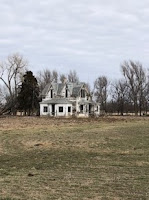Most of us think we know the traditions and history of May Day. Perhaps we imagine children dressed in spring colors, dancing around the maypole, a tradition we often associate with England. The maypole is traditional in many countries, however, including occasionally in America.
For me, May Day means devising some kind of container, whether it is a basket purchased at a store or a jelly jar wrapped with ribbon or some other container adequate to hold flowers. Ideally, it means finding flowers of some kind to be picked. Today, I look out my window and see lilacs in bloom, my early deep purple iris just beginning, and the blooming redbud trees. Not every year is so generous with available flowers, but silk flowers or weeds from a ditch will do just as well for the fun of May Day.
The best part for me, as a child, was always the delivery--hanging the basket on the front door, ringing the doorbell or knocking loudly, (since we didn't have a bell), and then running to hide somewhere that I could see the 'surprise' on my mother's face when the flowers were discovered.
While I did not make a May Day basket this year, I did fill the house with lilacs and a few early iris.
For many years, I knew nothing of another type of May Day celebration. In many countries, May 1st is a celebration for the labor movement. In those countries, the first of May is a national public holiday called "International Worker's Day" or some similar name.
Our present Labor Day is in September, but the history of our celebration can be traced to Chicago on May 4, 1886 when workers gathered in Haymarket Square to demonstrate for an 8-hour workday and safer working conditions. According to the Mayor who was in attendance that day, the demonstration was peaceful, but as the speaking ended and the police moved in to breakup the gathering, violence erupted. Tragically, deaths and miscarriages of justice followed.
The late 1800s were not only the era of the Populist Movement described in my book, Prairie Bachelor, but also a time of clashes between workers and their employers, including several famous strikes. Among them were both the Johnson County War in Wyoming, in which small farmer/ranchers confronted the illegally hired private army of the wealthy ranchers of the Wyoming Stock Growers Association, and the Homestead Lockout in which union workers confronted Pinkerton Detectives hired by Andrew Carnegie.
Another famous strike involved George Pullman. The Panic of 1893 caused a downturn in his railroad manufacturing plant, famous for its model town, with homes, parks, shops, and a library for his workers. Pullman responded to the economic downturn by cutting workers' wages; however, he did not reduced the rent workers paid for their houses in the model town. When a workers' committee went to Pullman to request a rent adjustment consistent with their pay cuts, he refused, and to make matters worse, he fired three of the committee members who had come to make the appeal for the workers. A strike followed.
Pullman was a powerful man with powerful friends, and using those connections resulted in the President sending Federal troops to break up the strike, despite the Governor's request that the troops be withdrawn. Without describing the events in detail, the sad result was that the decision to send in federal troops was the first time soldiers fired on and killed American citizens against the wishes of the executive of the state.
 |
| May Day in Helsinki, Finland |
The Federal Government had not declared a special Workers' Day at that time, although states had begun to declare a Labor Day for workers. Oregon was first, in 1887, and by 1894 thirty states had declared an official Labor Day. In a way that must have seemed disrespectful to some, six days after the Pullman Strike ended, President Cleveland and Congress rushed through legislation to establish Labor Day. However, that law only applied to a holiday for federal workers. Gradually, Labor Day as we know it was made a statutory holiday.
Returning to the history of May Day, the memory of the original labor effort has not been entirely forgotten. In addition to other nations recognizing May 1st as their labor celebrations, a few American cities celebrate Loyalty Day, and some bar associations hold Law Day events to celebrate the rule of law.
 |
| Bar Associations declare Law Day |
In addition, groups have sometimes referenced May Day's original connection with workers. May 1, 2012, Occupy Wall Street and labor unions held protests together. There was also a movement in 2020, during a time when workers felt that management was was not providing basic protection to workers during Covid-19, workers from such companies as Amazon, Whole Foods, Walmart, FedEx and Target threatened to walk out on their jobs on May Day.
I believe most of us think of Maypoles and baskets of flowers when May 1st arrives, but I hope you have enjoyed reading about other history related to that date.

















